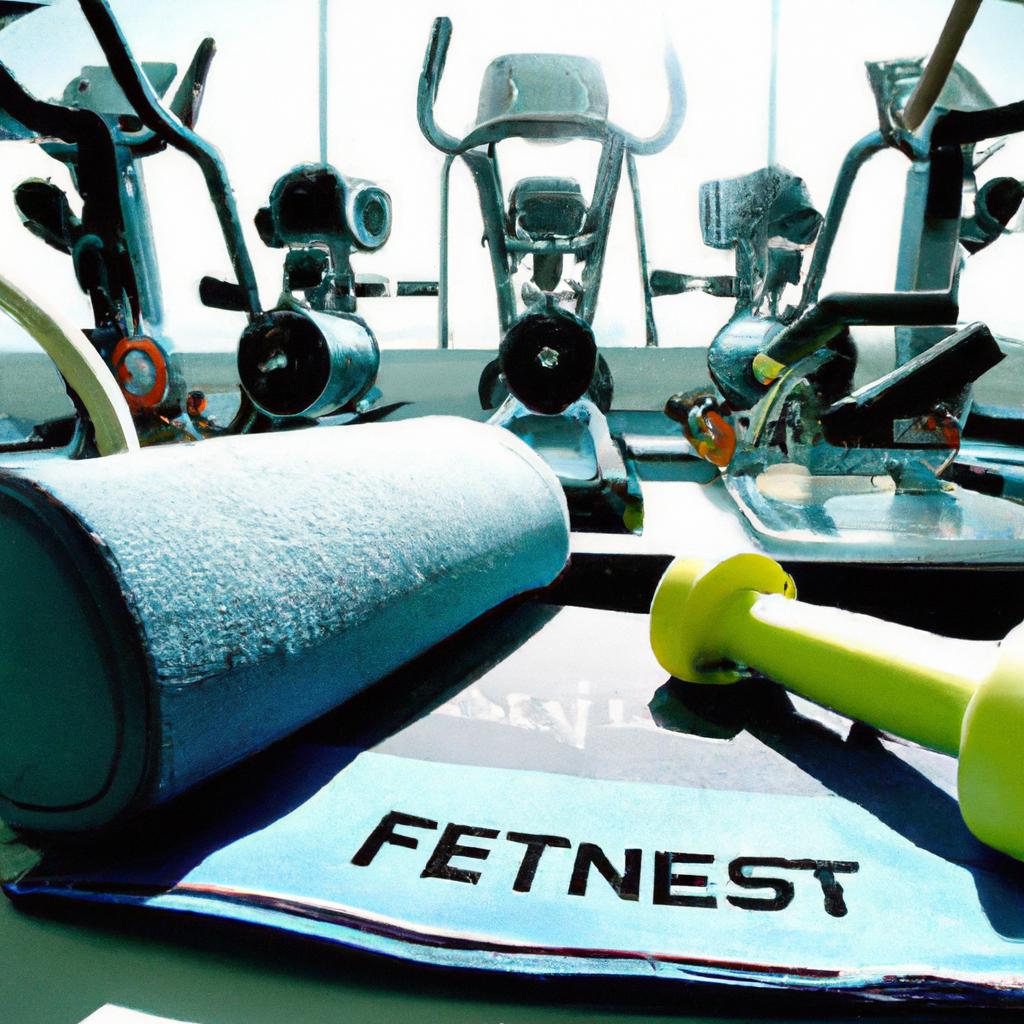🔥 Strength training 101: Everything you Need to Know
In a world where fitness trends come and go, strength training remains a steadfast cornerstone of physical well-being. Whether you’re a seasoned gym-goer or someone contemplating their first set of weights, the foundation of strength training holds a wealth of knowledge just waiting to be explored. Not only does strength training enhance muscle tone and boost metabolism, but it also fortifies bones, elevates mood, and improves overall functionality in daily life. In this comprehensive guide, we’ll demystify the essentials of strength training, unraveling the principles, techniques, and benefits that can transform your fitness journey. From understanding the perfect form to deciphering the best routines for your goals,join us as we embark on a journey through the dynamic world of strength training. Prepare to lift not just weights, but also your understanding of fitness as we delve into everything you need to know to build strength effectively and sustainably.
Table of contents
- Understanding the Fundamentals of Strength Training
- Choosing the Right Equipment for Your Fitness Journey
- Crafting an Effective strength Training Program
- nutrition and Recovery: The Unsung Heroes of Strength Training
- Q&A
- To Conclude
understanding the Fundamentals of Strength Training
Strength training is a powerful method for improving physical performance, enhancing muscle tone, and boosting metabolic efficiency. At its core, strength training involves using resistance to induce muscle contractions, which leads to increased muscle strength, size, and endurance. To grasp the fundamentals, it’s essential to understand the different forms of resistance used in workouts, including free weights, resistance bands, and bodyweight exercises. each method has its unique benefits and can be tailored to fit individual fitness goals.
When embarking on a strength training journey, it’s crucial to focus on the principles of progression. This includes gradually increasing the weight, changing the exercises, or adjusting the number of sets and repetitions to continuously challenge your muscles. Following a structured program can help prevent plateaus and maximize results. Here are some key principles to consider:
- Progressive Overload: Gradually increasing resistance to force muscles to adapt.
- specificity: Tailoring your training to your specific goals.
- Recovery: Allowing adequate rest days to enable muscle repair and growth.
In addition to understanding exercises and progression, knowing how to structure a workout is vital for success. Incorporating a mix of compound and isolation exercises can lead to a balanced approach to strength training. Compound exercises like squats, deadlifts, and bench presses engage multiple muscle groups, while isolation exercises focus on specific muscles. Here’s a sample workout structure:
| Exercise Type | Example Exercise | Targeted Muscles |
|---|---|---|
| Compound | Squats | quadriceps, Hamstrings, Glutes |
| Compound | Bench Press | Chest, Shoulders, triceps |
| Isolation | Bicep Curl | Biceps |
Choosing the Right Equipment for Your Fitness Journey
When embarking on your fitness journey, the right equipment can make all the difference in achieving your strength training goals. Whether you’re working out at home or in a gym,it’s essential to select gear that aligns with your personal preferences and workout style. Start by assessing your fitness goals, budget, and available space. This will help narrow down your options to find equipment that complements your routine.
Consider investing in a combination of free weights,resistance bands,and bodyweight exercises to create a balanced workout. Each type of equipment has its unique advantages:
- Free Weights: perfect for building strength and improving functional fitness.
- Resistance Bands: Versatile and portable, ideal for full-body workouts and rehabilitation.
- Bodyweight Exercises: Require no equipment and can be done anywhere, making them great for beginners.
Once you’ve persistent the types of equipment you want, it’s helpful to create a simple comparison of your options to aid in your decision-making. Here’s a speedy overview:
| Equipment | Price Range | Portability | Skill Level |
|---|---|---|---|
| Free Weights | $20 – $300 | Low | Beginner to advanced |
| Resistance Bands | $10 – $50 | High | All Levels |
| Bodyweight Training | Free | Very High | All Levels |
Crafting an Effective Strength Training Program
requires understanding your individual goals and the foundational elements of training. Start by defining your objectives—whether it’s building muscle, improving endurance, or increasing overall strength. Tailor your program to target these goals by incorporating a variety of exercises that promote muscular adaptation and growth.Some essential components to include are:
- Compound movements (e.g., squats, deadlifts, bench press) that engage multiple muscle groups.
- Isolation exercises (e.g., bicep curls, tricep extensions) to focus on specific muscles.
- Progressive overload to gradually increase weights and resistance over time.
To create balanced routines, structure your workouts around major muscle groups while allowing ample recovery time. A typical week could be designed with a split routine, such as:
| Day | Focus |
|---|---|
| Monday | Upper Body |
| Wednesday | Lower Body |
| Friday | Full Body |
It’s also crucial to monitor your progress and make adjustments as needed. Regularly evaluate your strength levels,exercise performance,and overall physical condition. Consider keeping a training journal to track your workouts, noting how you feel during and after each session. In doing so, you can identify what’s working, when to switch things up, or which exercises may need modification. Remember, the journey of strength training is about progression and enjoyment, so find the right balance that keeps you motivated!
Nutrition and Recovery: The Unsung Heroes of Strength Training
When we think of strength training, our minds frequently enough gravitate towards the weights, the techniques, and the sweat-slicked gym floors. However, the true foundation of progress lies beneath the surface—where nutrition and recovery play pivotal roles.Fueling the body with the right nutrients is essential for maximizing performance and facilitating growth. A balanced diet rich in protein, healthy fats, and complex carbohydrates not only supports muscle repair but also boosts energy levels, allowing you to lift heavier and push through those last few grueling reps. Here are some key components to consider:
- Proteins: Essential for muscle growth and repair. Aim for lean sources like chicken, fish, beans, and legumes.
- Carbohydrates: The body’s primary energy source. Whole grains, fruits, and vegetables are excellent for sustained energy.
- Fats: Important for hormonal balance and nutrient absorption. Incorporate healthy fats from avocados, nuts, and olive oil.
As important as nutrition is, recovery is the equally vital counterpart that allows our bodies to adapt and grow stronger. During the recovery phase,muscles undergo repair processes that ultimately lead to enhanced strength and performance. Overtraining without adequate rest can lead to burnout or injury, negating all the efforts put into training. Incorporating rest days, active recovery sessions, and proper sleep patterns can greatly enhance the body’s ability to recover. Here’s how you can optimize your recovery:
- Sleep: Aim for 7-9 hours of quality sleep each night to facilitate muscle recovery and hormone regulation.
- Hydration: Staying hydrated aids in nutrient delivery and muscle function. Drink plenty of water before, during, and after workouts.
- foam Rolling: Incorporating foam rolling or massage therapy can definitely help alleviate muscle soreness and enhance circulation.
Understanding the harmonious relationship between nutrition and recovery can transform your strength training experience. Instead of viewing training as a solitary aspect, consider it part of a larger ecosystem where food and rest are just as crucial. This holistic approach will not only yield better results but will also sustain your motivation and well-being throughout your fitness journey. By mindfully addressing these elements, you’re setting the stage for a triumphant training regimen that thrives on resilience and growth.
Q&A
Q&A: Strength Training 101: Everything you Need to Know
Q1: What is strength training and why is it important?
A1: strength training, also known as resistance training, involves exercises designed to improve strength and endurance. this practice is crucial as it helps build lean muscle mass, increases metabolic rate, enhances bone density, and improves overall functional fitness. Additionally, it can prevent injuries and address muscle imbalances.
Q2: How often should I incorporate strength training into my fitness routine?
A2: For most individuals, incorporating strength training 2 to 3 times per week is sufficient for noticeable results. It’s important to allow muscles to recover, so aim for a rest day between sessions focused on the same muscle groups.Q3: What equipment do I need to start strength training?
A3: You don’t need an elaborate gym setup to get started! Basic tools include resistance bands,dumbbells,kettlebells,and even your own body weight. Many effective exercises, like push-ups and squats, require no equipment at all!
Q4: Can beginners really benefit from strength training?
A4: Absolutely! Strength training is for all fitness levels, including beginners. Starting with lighter weights or bodyweight exercises can help new trainees learn proper form and gradually build strength without risking injury.Q5: What are some basic exercises I should know?
A5: Essential strength training exercises include:
- Squats
- Deadlifts
- Bench Press
- Rows
- overhead Press
These moves target major muscle groups and can be modified to suit different fitness levels.
Q6: How can I track my progress in strength training?
A6: Keeping a training journal or using fitness apps can be incredibly helpful. track metrics like the weights used, number of sets and reps completed, and how you feel after workouts. Progress can also be measured in terms of how much easier exercises become over time.
Q7: Is strength training safe for everyone,including older adults?
A7: Yes,strength training is generally safe for all ages,including older adults. Actually, it’s highly beneficial as it combats the natural decline in muscle mass associated with aging. However, it’s always wise to consult a healthcare professional before beginning any new exercise regime, especially if there are existing health concerns.
Q8: Can strength training help with weight management?
A8: Definitely! Strength training builds muscle tissue, which requires more energy (calories) to maintain than fat tissue. This increased muscle mass can boost your resting metabolic rate, making it easier to manage weight over time in combination with a balanced diet.
Q9: What mistakes should I avoid as a beginner?
A9: Some common pitfalls include skipping warm-ups, using weights that are too heavy, neglecting proper form, and not allowing enough recovery time. Patience is key; it’s better to start slow and build up gradually than to risk injury from overexertion.
Q10: where can I find reliable resources for further data?
A10: There are countless resources available, including reputable fitness websites, books written by certified trainers, and online courses. Additionally, consider joining a local gym or fitness class where you can receive guidance from professionals.
Conclusion:
With these insights,you’re well on your way to embarking on or enhancing your strength training journey.Remember, the most important part is to stay consistent and listen to your body. Happy lifting!
To Conclude
As we wrap up our deep dive into the world of strength training, it’s clear that this multifaceted practice is more than just lifting weights; it’s a commitment to building not only muscle but also resilience, discipline, and confidence. Whether you’re a seasoned athlete or a complete beginner, the key takeaway is that strength training offers a unique tapestry of benefits that can be tailored to fit individual goals and lifestyles.
Remember, every individual’s journey will differ, shaped by personal motivations and physical capabilities. Embrace the process as you discover which methods resonate most with you and your body. As you step into the gym—whether it’s a local facility or the comfort of your home—keep in mind that each rep contributes to a healthier, stronger you.
So, take that first step, set those intentions, and don’t shy away from seeking guidance when needed. The strength training world is vast and empowering, waiting for you to explore its depths. Here’s to your journey—may you lift not just weights, but also the barriers holding you back. Happy training! 💪




